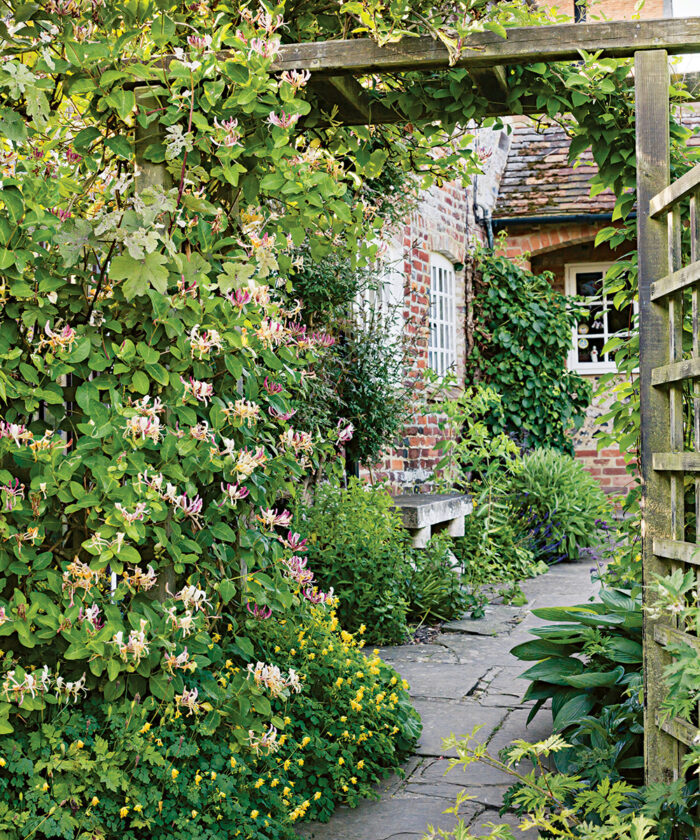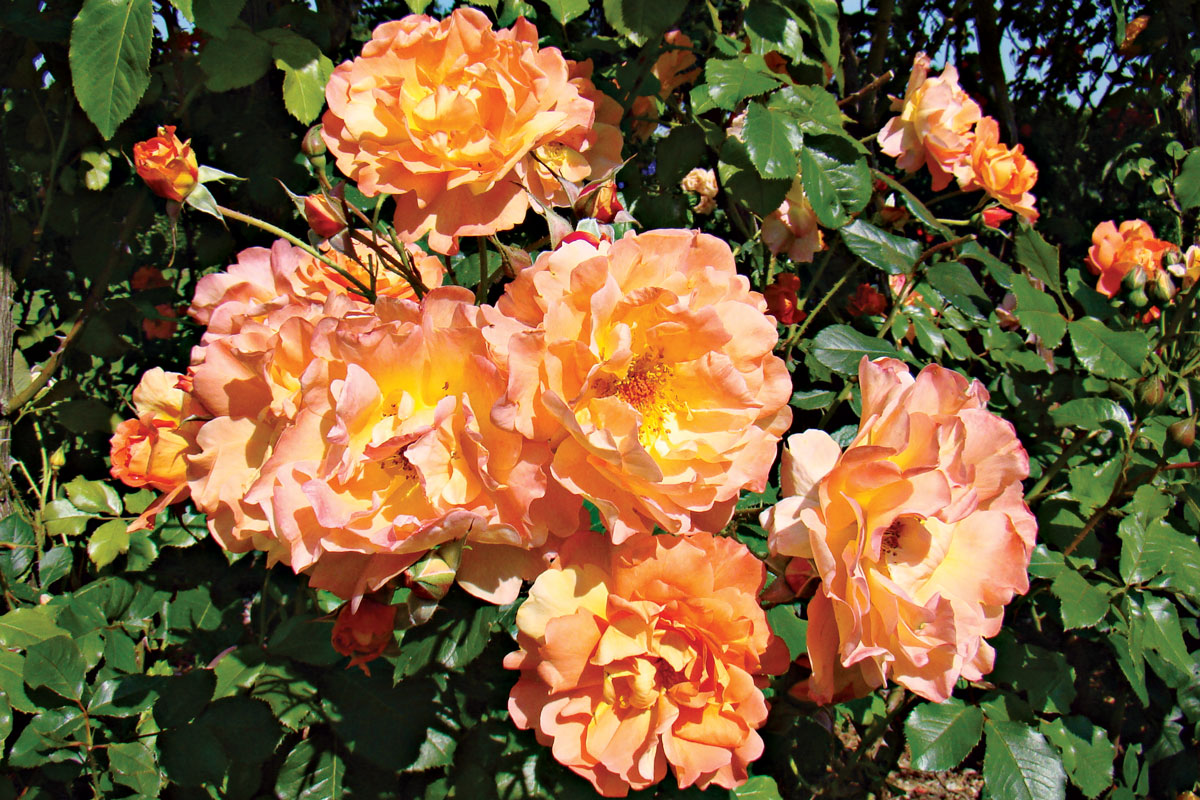
While far from the only unruly things growing in our gardens, vines always seem to be the poster children for invasive plants. Many years ago, when Brushwood Nursery was young, we participated in on-site sales events at public gardens. I distinctly remember some visitors walking past our tables and making comments like “Ugh, vines!” and “Can you even imagine that in my garden?” It’s true that the mature size and habit of any plant should be considered when adding it to your landscape, but there are many great vines and climbers that fit in well and behave themselves while bringing beauty in a way other plants just can’t.
The following are some great choices that won’t consume your car when you turn your back. Some are possibly surprising, while others are “good cousins” to known garden bullies or invasive vines. I think it’s a shame when an entire genus is disparaged because one or more species are poor choices. Whether you’re looking to add some interest to hard-to-reach or lifeless places, or to cover up an eyesore, you’re sure to find something you like here.
Florida’ Dutch honeysuckle serves as an excellent hummingbird magnet

Name: Lonicera periclymenum ‘Florida’ (syn. L. periclymenum ‘Serotina’)
Zones: 5–9
Size: 18 feet tall and 3 to 6 feet wide
Conditions: Full sun to partial shade; rich, moist, well-drained soil
Native Range: Europe, North Africa, southwestern Asia
When to Prune: Mid to late summer (immediately after flowering)
Honeysuckles get a bad rap, right? It’s unfortunate that a few invasive species ruin it for the other generous yet perfectly polite honeysuckles. ‘Florida’ Dutch honeysuckle is a prime example. This bountiful climber is a particularly compact form sporting rich colors that start with deep red-purple buds and open to reveal creamy white petals that mature through butter yellow to gold. It also has a pleasant fragrance, attracts hummingbirds, and is deer resistant. If needed, keeping ‘Florida’ a little shorter is easy to do with a snip here and there. It works well on a trellis or wires, where it will happily twine and give you hundreds of flowers in summer. I like it best on an arch over a walkway, where the intricacies of the flowers and the fragrance can both be appreciated (top photo).
Westerland climbing rose is a fragrant, disease-resistant delight

Name: Rosa ‘KORwest’
Zones: 5–11
Size: 12 feet tall and 4 to 6 feet wide
Conditions: Full sun to partial shade; fertile, moist, well-drained soil
Native Range: Hybrid
When to Prune: Late winter
I like roses—really, I do. But there are only a few I love. Westerland checks all of the boxes for me. It’s a sturdy climber that trains well and has good disease resistance. I’ve seen it trained into the lower branches of an old fruit tree, where it filled in quite nicely without bothering its host. This rose’s deliciously fragrant, steady repeat blooms shine in multiple shades of apricot, orange, and copper all summer. It teams up well with purple large-flowered clematis (Clematis cvs., Zones 4–9) such as ‘The President’ and ‘Rhapsody’. Climbing roses and clematis make great partners, as they both enjoy rich, well-drained soil with regular irrigation during the growing season. Because most clematis are pruned back in winter, it’s easy to see what the rose needs then too. I use Espoma Rose-tone organic fertilizer liberally several times throughout spring and summer—and both plants love it.
Liberty® clematis produces colorful flowers on a compact form

Name: Clematis ‘Zo08095’
Zones: 6–9
Size: 4 to 6 feet tall and 2 to 3 feet wide
Conditions: Full sun to partial shade; fertile, moist, well-drained soil
Native Range: Hybrid
When to Prune: Late winter
No list of well-behaved climbers would be complete without a clematis on it. While a few species can be invasive in some places, the vast majority are tame and suitable for most settings. One of my new favorites is Liberty® clematis. Its 5-inch flowers feature a stunning pale pink base with veins and margins in rich magenta red. They are abundant on the vine in late spring and repeat into summer. A colorful and quite compact new hybrid, Liberty® fits in just about anywhere in a garden—including containers. As with many clematis varieties, I find the seed heads ornamental as well—like something from a Dr. Seuss story. Liberty® has demonstrated cold hardiness to Zone 6, but I think it will prove hardier farther north. Like other large-flowered hybrid clematis, Liberty® takes a little while to establish but is worth the wait. Aside from an annual pruning back to 1 to 2 feet tall, this vine requires very little extra care once established.
‘Longwood Purple’ American wisteria provides a noninvasive wisteria option

Name: Wisteria frutescens ‘Longwood Purple’
Zones: 4–9
Size: 25 feet tall and 4 to 8 feet wide
Conditions: Full sun to partial shade; fertile, moist, well-drained soil
Native Range: Eastern United States
When to Prune: Late winter and early summer (after flowering)
A tame wisteria—really? Yes, indeed, you can grow wisteria without fear. It’s important not to dismiss an entire genus because some species are invasive. This selection from the famous Longwood Gardens has been gracing my garden for decades, where it gives generously without being a bully. The fragrant lilac-purple blooms are intoxicating from midspring into early summer—with possible repeat blooms in fall under shady conditions.
Sure, regular pruning is necessary to keep this vine from getting into things, but it’s nothing like its Asian counterparts W. floribunda (Zones 4–9) and W. sinensis (Zones 5–8), which seed and run all over the place. Even though ‘Longwood Purple’ is a tamer wisteria, it’s essential to provide it with very sturdy support. Lattice works at first, but the stems will swell over time and break lighter structures. I prefer 4-inch by 4-inch wooden posts and steel. Once ‘Longwood Purple’ is in place, annual late winter pruning is all that’s needed. However, if you’d like to keep it in a more compact state, give it a little trim in summer.
‘Morning Calm’ trumpet vine is an adaptable large-scale climber

Name: Campsis grandiflora ‘Morning Calm’
Zones: 6–9
Size: 16 to 20 feet tall and 6 to 9 feet wide
Conditions: Full sun to partial shade; average, well-drained soil
Native Range: China
When to Prune: Late winter or early spring
I’m a fan of planting natives, but our native trumpet vine (C. radicans and cvs., Zones 4–10) can really get out of hand from both runners and seed. ‘Morning Calm’ is a worthy substitute from Asia that’s much tamer and rarely sets seed. The larger, peachy corollas on its flowers are showy and abundant throughout summer. Hummingbirds and other pollinators love it too. It appreciates good soil but is generally adaptable. While considered a self-clinging vine, this selection does need training and support. I’ve found it most prolific in bloom when each stem is allowed to arch outward and even down, showing off dozens of flowers at the tip. Give ‘Morning Calm’ some room to perform, but don’t worry about it taking liberties with your generosity.
Rosy crabapple kiwi adds a touch of elegance with its variegated foliage

Name: Actinidia tetramera var. maloides
Zones: 6–9
Size: 20 feet tall and 8 to 12 feet wide
Conditions: Partial shade; fertile, well-drained soil
Native Range: Asia
When to Prune: Late winter
If you’re looking for elegance, rosy crabapple kiwi is the perfect vine for you. I fell in love with this rarity while visiting Crug Farm Nursery in Wales, where it filled a wall of an ancient barn. The support structure was a combination of iron bars and wires, which suited this twiner. The dignified dark green foliage is slender and has nice white tips. The leaves make a wonderful backdrop for the spring blooms, which have a rich, rosy-pink hue that really catches the eye. While it can quickly cover your favorite sturdy trellis or arbor, it’s easy to keep in check if needed. This lovely species is not as cold hardy as the more common arctic kiwi (A. kolomikta and cvs., Zones 4–8), but it has the potential to be a standout climber wherever it’s grown.
Climbing Carolina aster is a pollinator-friendly, fall-blooming native

Name: Ampelaster carolinianus
Zones: 6–9
Size: 10 to 15 feet tall and 3 to 6 feet wide
Conditions: Full sun to partial shade; average, moist, well-drained soil
Native Range: Southeastern United States
When to Prune: Late winter
Here’s another beauty I first saw growing at Longwood Gardens in fall. Tucked into a quiet corner of the Idea Garden, it was displaying an abundance of small lavender blooms. I’ve been growing it ever since and have estimated over a thousand flowers on it at once in my garden! I especially like this native species for my honeybees and native pollinators, who benefit from the flowers at a time when little else is blooming. At the northern end of its hardiness range, climbing Carolina aster will be fully herbaceous and max out at about 6 feet tall, which is fine because it comes back strong and has plenty of time to build up before flowering. In more southern locales, it reaches its full height. It’s exceptionally easy to grow, taking a wide range of soil conditions, and is drought tolerant once established. I cut it back to 2 feet tall before the start of the growing season, and it springs back up fuller each year.
Fantastic tropical options that are worth the extra effort
Tender ornamental vines are also a great choice for livening up structures near entryways and patios, and in containers. Even though they are not cold hardy, they provide extended periods of bloom or interesting foliage and are guaranteed to stay in check because their season of growth is limited.
‘Damsel’s Delight’ passionflower

‘Damsel’s Delight’ passionflower (Passiflora ‘Damsel’s Delight’, Zones 8–11) is a stunning new hybrid from England. Reaching up to 10 to 15 feet tall and wide, this passionflower fills in quickly and bears large flowers with strikingly intense coloration on a backdrop of dark green foliage. It will bloom continuously in warm weather—just be sure to provide it with full sun and good fertility for the best performance.
‘Ogon Nishiki’ star jasmine

‘Ogon Nishiki’ star jasmine (Trachelospermum ‘Ogon Nishiki’, Zones 7–11) shines with amazing multi-colored foliage that features striking markings in shades of orange, gold, and green. Although it’s capable of being trained as a climber (up to 20 feet tall and 10 feet wide over time), I actually love it best as a 6- to 12-inch-tall ground cover or spiller in a container. ‘Ogon Nishiki’ prefers full sun to partial shade and is very adaptable to various soil and climate conditions
Rex begonia vine
Rex begonia vine (Cissus discolor, Zone 11) has insignificant flowers, but with this foliage, who cares? The stunning leaves dazzle with a green and wine-colored base etched with silver markings. At 6 to 8 feet tall and 1 to 3 feet wide, this vine is visually intense yet refined on the front and back sides of the leaves. Even the square stems are lovely. It likes partial shade and moist, but not sopping wet, soil.
Dan Long is the owner of Brushwood Nursery, a mail-order plant resource in Athens, Georgia, that specializes in vines and climbers.
Sources:
- Antique Rose Emporium, Brenham, TX; 800-441-0002; antiqueroseemporium.com
- Brushwood Nursery, Athens, GA; brushwoodnursery.com
- Forestfarm at Pacifica, Williams, OR; 541-846-7269; forestfarm.com
- Steve’s Leaves, Lewisville, TX; 214-368-0530; stevesleaves.com
Fine Gardening Recommended Products

Corona E-Grip Trowel
Fine Gardening receives a commission for items purchased through links on this site, including Amazon Associates and other affiliate advertising programs.

Corona® Multi-Purpose Metal Mini Garden Shovel
Fine Gardening receives a commission for items purchased through links on this site, including Amazon Associates and other affiliate advertising programs.




















Comments
Log in or create an account to post a comment.
Sign up Log in